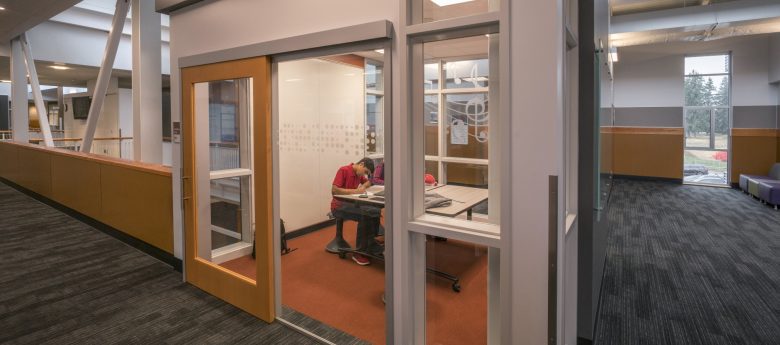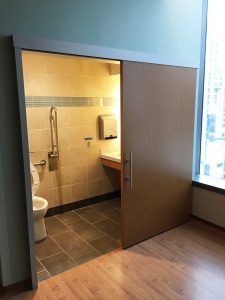Sliding Doors Meet Today’s Accessible Design

With the wave of a hand or the press of a button, today’s generation has instant access to technology never before imagined. Accessibility standards similarly follow suit, with automation now becoming the next frontier driving building design. In schools and health care facilities, automated systems have vastly improved the lives of those with disabilities. Long gone are the days when students and staff or medical patients with impaired physical abilities or limited mobility have to struggle with pushing open heavy doors in facilities such as municipalities, universities, K-12 schools, and hospitals (MUSH facilities). Let’s begin with a look at the history of accessible building design in the United States to see just how far it has come.
A Brief History
In the last 30 years, there have been significant changes to accessible design. Starting in 1986, the National Council on Disability (NCD) issued a report that brought awareness to discrimination on the basis of disability and made legislative recommendations on how to achieve equal opportunity for Americans with disabilities.
Over the next few years, the NCD brought their reports before congress. And shortly thereafter in 1990, the American with Disabilities Act (ADA) was passed into law. Naturally, the act has led to design regulations across the building industry, educational and medical facilities included.
Meeting Current ADA Standards
As a result of the 1990 ADA law, manufacturers are continually implementing innovative solutions to meet and exceed accessibility codes and standards. Currently, these standards state that “doorways shall have a minimum clear opening of 32 in. (815 mm) with the door open 90 degrees, measured between the face of the door and the opposite stop.” While design teams can use traditional swing doors to meet these criteria, this approach can prove challenging if space is limited. For example, consider cramped hospital rooms and small school bathrooms, where hallways are tight and square footage is at a premium. In these situations, disabled students and patients have the added difficulty of having to maneuver in and out of narrow spaces.
However, modern-interior commercial sliding door systems can meet required ADA standards and more, overcoming spatial challenges with barn door styles, hardware and self-closing features.
Barn Door Style
Sliding door systems are commonly designed in the barn door style, adhering to ADA compliance standards, while serving as a stylish solution across a variety of settings. These ADA-approved barn doors can be easier to navigate since building occupants don’t have to maneuver around a swinging door.

For example, during Southeast Health’s renovation, the design team needed to ensure the Dothan, Alabama medical center’s design would meet accessibility codes. Architects chose to include durable wood barn doors to the entrance of the patient rooms to add style and function to the space. In application, these sliding barn doors provide patients with the ease of coming and going in wheelchairs without the fear that a door may open unexpectedly in their path.
In the case of Southeast Health, another consideration designers needed to take into account was providing large doorway openings to accommodate patients requiring assistance or using wheelchairs or other devices. A solution was found through the use of a surface mounted sliding barn door, which increased the amount of usable space available to patients and providers – improving both efficiency and comfort. The specialty sliding doors used at Southeast were also designed to integrate the optional use of patient bed lifts, further accommodating the needs of patients and their care providers.
Hardware Compliance
To ensure ease of operation for building occupants, handle clearance is another important element to consider. Door handle placement is key. Think of the effort required by a student or patient in a wheelchair, including those who may have to use a prosthesis, to reach a high door handle. In cases such as these, making sure the door handle placement is within reach of those with physical disabilities becomes vital. To address this concern, some door manufacturers offer interior sliding door systems with proper handle clearances of no more than 34 in. off the ground, an opening force of five pounds maximum, and hardware solutions that do not require pinching, twisting or grasping or special knowledge to operate.
Clear openings and a reduction in trip hazards are also critical when it comes to the hardware system surrounding a door. Modern sliding door systems go beyond efficient use of space, improving access for patients and staff. The construction of Houston Methodist Hospital’s Paula and Joseph C. “Rusty” Walter III Tower is a case-in-point. Building design professionals utilized surface-mounted, top-hung barn door-style sliding doors to meet ADA requirements. To aid in the barn door style orientation, quiet top-hung roller hardware was installed instead of traditional floor tracks, preventing the risk of trip hazards and increasing staff efficiency John Kennedy, the account manager for the construction company in charge of the project, American Direct said, “Unlike traditional swing doors, sliding doors maximize the space in an efficient way, producing a fluid environment and easing traffic congestion even during peak usage times.”
Self-Closing Options
Going one step further, manufacturers are improving accessibility through self-closing door options. In hospitals or healthcare centers, this automated functionality reduces strain on occupants with limited mobility and nursing staff carrying heavy loads. Areas where infection control, air infiltration or security is a concern further benefit from this solution. Many sliding door systems now offer optional self-closing capabilities that include soft-closing mechanisms to ensure the door closes at the right speed, based on ADA requirements. This ability helps occupants move freely throughout the space, while still providing a durable, safe environment for patients and staff.
Next-Level Accessibility
For spaces that demand more accessible design that typical manually operated sliders can provide, full automation on surface mounted sliding doors can now deliver unprecedented levels of accessibility. Interior sliding door systems are available with a low-energy automatic operator with safety sensors to meet or exceed ADA’s accessibility requirements. This automation is especially helpful to those with physical disabilities or limited mobility and worth considering for safer, more accessible spaces or where security or air infiltration is of concern. There are many accessibility-friendly options for actuating automatic surface mounted sliders such as wave or occupancy sensors, push buttons or even designs that integrate with access control.
With cutting-edge technology continually being invented for sliding door systems, a world of possibilities is now available to serve those with disabilities. Advances such as automation in sliding door systems help to simplify the movement required of impaired building occupants in MUSH facilities to access spaces, and further provide solutions for building professionals designing for accessibility. The future of accessible design is bright and sliding door systems are just the beginning.
Tysen Gannon, LEED AP, is director of business development for AD Systems. Gannon has more than 15 years of experience in the architectural products industry, including roles in sales, product management, research and marketing, with a focus on glass and glazing, fenestration and façade systems.
